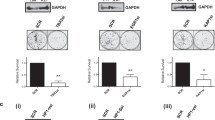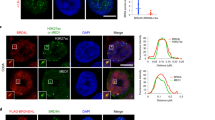Abstract
Oncogenic transformation of cells can induce the cyclin-dependent kinase inhibitor, p16, which leads to hypophosphorylation and activation of retinoblastoma (Rb). Rb is capable of causing permanent growth arrest, which may underlie its role as a tumor suppressor. We show that repression by Rb at E2F target gene promoters involves the establishment of a stable repressor complex that is not displaced by the overexpression of E2F-1. Rather than displacing Rb, excess E2F-1 instead recruits more Rb, leading to direct transcriptional repression. In contrast, the Rb family members, p130 and p107, which have not been demonstrated to be tumor suppressors, bind preferentially to target promoters in the absence of growth factors and in proliferating cells, respectively, and these repressor complexes are displaceable by E2F-1. Heterochromatin protein 1 (HP1), which interacts with Rb, is associated with these distinct repressor complexes and follows a similar pattern of stability/displaceability. Efficient growth arrest by p16/Rb is dependent on histone H3 lysine 9 methylation, which provides a binding site for HP1. We propose that these differences in the stability of repressor complexes at promoters may, in part, underlie the different roles of Rb vs p130 and p107 in cell cycle regulation and tumor suppression.
This is a preview of subscription content, access via your institution
Access options
Subscribe to this journal
Receive 50 print issues and online access
$259.00 per year
only $5.18 per issue
Buy this article
- Purchase on Springer Link
- Instant access to full article PDF
Prices may be subject to local taxes which are calculated during checkout






Similar content being viewed by others
References
Ait-Si-Ali S, Polesskaya A, Filleur S, Ferreira R, Duquet A, Robin P, Vervish A, Trouche D, Cabon F and Harel-Bellan A . (2000). Oncogene, 19, 2430–2437.
Bannister AJ, Zegerman P, Partridge JF, Miska EA, Thomas JO, Allshire RC and Kouzarides T . (2001). Nature, 410, 120–124.
Calbo J, Parreno M, Sotillo E, Yong T, Mazo A, Garriga J and Grana X . (2002). J. Biol. Chem., 277, 50263–50274.
Cheutin T, McNairn AJ, Jenuwein T, Gilbert DM, Singh PB and Misteli T . (2003). Science, 299, 721–725.
Clarke AR, Maandag ER, van Roon M, van der Lugt NM, van der Valk M, Hooper ML, Berns A and te Riele H . (1992). Nature, 359, 328–330.
Classon M and Dyson N . (2001). Exp. Cell Res., 264, 135–147.
Cobrinik D, Lee MH, Hannon G, Mulligan G, Bronson RT, Dyson N, Harlow E, Beach D, Weinberg RA and Jacks T . (1996). Genes Dev., 10, 1633–1644.
Dai CY and Enders GH . (2000). Oncogene, 19, 1613–1622.
DeGregori J, Leone G, Miron A, Jakoi L and Nevins JR . (1997). Proc. Natl. Acad. Sci. USA, 94, 7245–7450.
Dyson N . (1998). Genes Dev., 12, 2245–2262.
Festenstein R, Pagakis SN, Hiragami K, Lyon D, Verreault A, Sekkali B and Kioussis D . (2003). Science, 299, 719–721.
Harbour JW and Dean DC . (2000). Genes Dev., 14, 2393–2409.
Huber HE, Goodhart PJ and Huang PS . (1994). J. Biol. Chem., 269, 6999–7005.
Ishida S, Huang E, Zuzan H, Spang R, Leone G, West M and Nevins JR . (2001). Mol. Cell. Biol., 21, 4684–4699.
Jacks T, Fazeli A, Schmitt EM, Bronson RT, Goodell MA and Weinberg RA . (1992). Nature, 359, 295–300.
Kuo MH and Allis CD . (1998). BioEssays, 20, 615–626.
Lachner M, O’Carroll D, Rea S, Mechtler K and Jenuwein T . (2001). Nature, 410, 116–120.
Laiho M, DeCaprio JA, Ludlow JW, Livingston DM and Massague J . (1990). Cell, 62, 175–185.
Lee EY, Cam H, Ziebold U, Rayman JB, Lees JA and Dynlacht BD . (2002). Cancer Cell, 2, 463–472.
Lee MH, Williams BO, Mulligan G, Mukai S, Bronson RT, Dyson N, Harlow E and Jacks T . (1996). Genes Dev., 10, 1621–1632.
Lipinski MM and Jacks T . (1999a). Oncogene, 18, 7873–7882.
Lipinski MM and Jacks T . (1999b). Proc. Natl. Acad. Sci. USA, 92, 6289–6293.
Littlewood TD, Hancock DC, Danielian PS, Parkern MG and Evan GI . (1995). Nucleic Acids Res., 23, 1686–1690.
Lomazzi M, Moroni MC, Jensen MR, Frittoli E and Helin K . (2002). Nat. Genet., 31, 190–194.
Lukas J, Parry D, Aagaard L, Mann DJ, Bartkova J, Strauss M, Peters G and Bartek J . (1995). Nature, 375, 503–506.
Luo RX, Postigo AA and Dean DC . (1998). Cell, 92, 463–473.
McConnell BB, Gregory FJ, Stott FJ, Hara E and Peters G . (1999). Mol. Cell. Biol., 19, 1981–1989.
Medema RH, Herrera RE, Lam F and Weinberg RA . (1995). Proc. Natl. Acad. Sci. USA, 92, 6289–6293.
Nakayama J, Rice JC, Strahl BD, Allis CD and Grewal SI . (2001). Science, 292, 110–113.
Narita M, Nunez S, Heard E, Narita M, Lin AW, Hearn SA, Spector DL, Hannon GJ and Lowe SW . (2003). Cell, 113, 703–716.
Nevins JR . (1998). Cell Growth Differ., 9, 585–593.
Nicolas E, Roumillac C and Trouche D . (2003). Mol. Cell. Biol., 23, 1614–1622.
Nielsen SJ, Schneider R, Bauer UM, Bannister AJ, Morrison A, O'Carroll D, Firestein R, Cleary M, Jenuwein T, Herrera RE and Kouzarides T . (2001). Nature, 412, 515–561.
Palmero I and Peters G . (1996). Cancer Surv., 27, 351–367.
Peters AH, O'Carroll D, Scherthan H, Mechtler K, Sauer S, Schofer C, Weipoltshammer K, Pagani M, Lachner M, Kohlmaier A, Opravil S, Doyle M, Sibilia M and Jenuwein T . (2001). Cell, 107, 323–337.
Rayman JB, Takahashi Y, Indjeian VB, Dannenberg JH, Catchpole S, Watson RJ, te Riele H and Dynlacht BD . (2002). Genes Dev., 16, 933–947.
Rice JC and Allis CD . (2001). Curr. Opin. Cell Biol., 13, 263–273.
Sellers WR, Novitch BG, Miyake S, Heith A, Otterson GA, Kaye FJ, Lassar AB and Kaelin Jr WG . (1998). Genes Dev., 12, 95–106.
Serrano M, Lin AW, McCurrach ME, Beach D and Lowe SW . (1997). Cell, 88, 593–602.
Shan B and Lee WH . (1994). Mol. Cell. Biol., 14, 8166–8173.
Singh P, Coe J and Hong W . (1995). Nature, 374, 562–565.
Takahashi Y, Rayman JB and Dynlacht BD . (2000). Genes Dev., 14, 804–816.
Thomas DM, Carty SA, Piscopo DM, Lee JS, Wang WF, Forrester WC and Hinds PW . (2001). Mol. Cell, 8, 303–316.
Trouche D, Cook A and Kouzarides T . (1996). Nucleic Acids Res., 24, 4139–4145.
Vandel L, Nicolas E, Vaute O, Ferreira R, Ait-Si-Ali S and Trouche D . (2001). Mol. Cell. Biol., 21, 6484–6494.
Vigo E, Muller H, Prosperini E, Hateboer G, Cartwright P, Moroni MC and Helin K . (1999). Mol. Cell. Biol., 19, 6379–6395.
Wang J and Walsh K . (1996). Cell Growth Differ., 7, 1471–1478.
Wells J, Boyd KE, Fry CJ, Bartley SM and Farnham PJ . (2000). Mol. Cell. Biol., 20, 5797–5807.
Wu L, de Bruin A, Saavedra HI, Starovic M, Trimboli A, Yang Y, Opavska J, Wilson P, Thompson JC, Ostrowski MC, Rosol TJ, Woollett LA, Weinstein M, Cross JC, Robinson ML and Leone G . (2003). Nature, 421, 942–947.
Young AP and Longmore GD . (2003). Oncogene, 22, 7209–7217.
Zhang HS, Gavin M, Dahiya A, Postigo AA, Ma D, Luo RX, Harbour JW and Dean DC . (2000). Cell, 101, 79–89.
Zhang HS, Postigo AA and Dean C . (1999). Cell, 97, 53–61.
Zindy F, Quelle DE, Roussel MF and Sherr CJ . (1997). Oncogene, 15, 203–211.
Acknowledgements
We thank Jason Weber for helpful comments on the manuscript; Gordon Peters for EH1 cells; Kristian Helin for anti-E2F1 amino-terminus antibody and pBabeHAERE2F1; Gerard Evan for the tamoxifen-responsive estrogen receptor construct; David Johnson for GST-E2F1; Tyler Jacks for Rb−/− MEFs; Thomas Jenuwein for Suv39H1/H2 double knockout cells; and Douglas Dean for previous intellectual contribution and support. This work was supported by grants from the National Institutes of Health (CA 85839) and the American Heart Association (EI9940116N) to GDL.
Author information
Authors and Affiliations
Corresponding author
Rights and permissions
About this article
Cite this article
Young, A., Longmore, G. Differences in stability of repressor complexes at promoters underlie distinct roles for Rb family members. Oncogene 23, 814–823 (2004). https://doi.org/10.1038/sj.onc.1207187
Received:
Revised:
Accepted:
Published:
Issue Date:
DOI: https://doi.org/10.1038/sj.onc.1207187
Keywords
This article is cited by
-
Retinoblastoma family genes
Oncogene (2006)
-
The E2F family: specific functions and overlapping interests
The EMBO Journal (2004)



